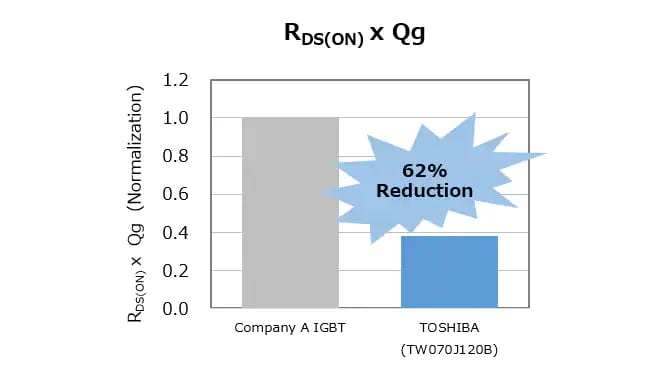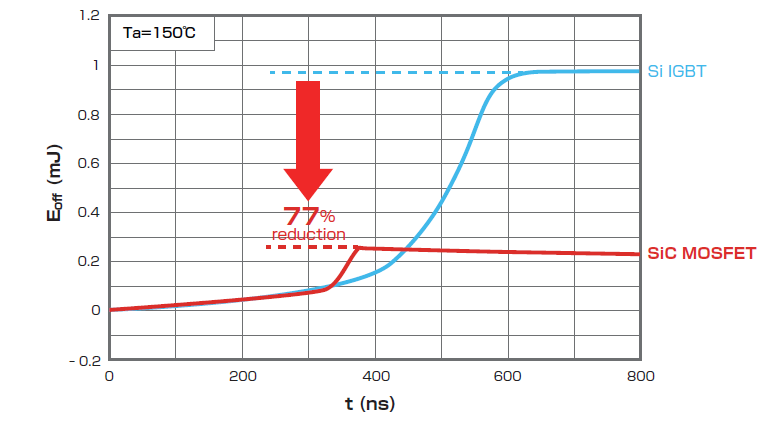- General Top
- SEMICONDUCTOR
- STORAGE
- COMPANY
-
My ToshibaSemicon
- Semiconductor Top
-
ApplicationsAutomotive
Body Electronics
xEV
In-Vehicle Infotainment
Advanced Driver-Assistance Systems (ADAS)
Chassis
IndustrialInfrastructure
BEMS/HEMS
Factory Automation
Commercial Equipment
Consumer/PersonalIoT Equipment
Healthcare
Wearable Device
Mobile
Computer Peripherals
-
ProductsAutomotive Devices
Discrete Semiconductor
Diodes
Transistors
Logic ICs
Analog Devices
Digital Devices
Wireless Devices
※
: Products list (parametric search)
Power SemiconductorsSiC Power Devices
※
: Products list (parametric search)
Isolators/Solid State RelaysPhotocouplers
Digital Isolators
Solid State Relays
Fiber Optic Transmitting Modules
※
: Products list (parametric search)
MOSFETsIGBTs/IEGTsBipolar Transistors※
: Products list (parametric search)
Diodes※
: Products list (parametric search)
MicrocontrollersMotor Driver ICsIntelligent Power ICs※
: Products list (parametric search)
Power Management ICsLinear ICs※
: Products list (parametric search)
General Purpose Logic ICsLinear Image SensorsOther Product ICsOther Product ICs
※
: Products list (parametric search)
-
Design & Development
-
Knowledge
- Where To Buy
- Part Number & Keyword Search
- Cross Reference Search
- Parametric Search
- Stock Check & Purchase
This webpage doesn't work with Internet Explorer. Please use the latest version of Google Chrome, Microsoft Edge, Mozilla Firefox or Safari.
require 3 characters or more. Search for multiple part numbers fromhere.
The information presented in this cross reference is based on TOSHIBA's selection criteria and should be treated as a suggestion only. Please carefully review the latest versions of all relevant information on the TOSHIBA products, including without limitation data sheets and validate all operating parameters of the TOSHIBA products to ensure that the suggested TOSHIBA products are truly compatible with your design and application.Please note that this cross reference is based on TOSHIBA's estimate of compatibility with other manufacturers' products, based on other manufacturers' published data, at the time the data was collected.TOSHIBA is not responsible for any incorrect or incomplete information. Information is subject to change at any time without notice.
require 3 characters or more.
5 kW Isolated Bidirectional DC-DC Converter Reference Design
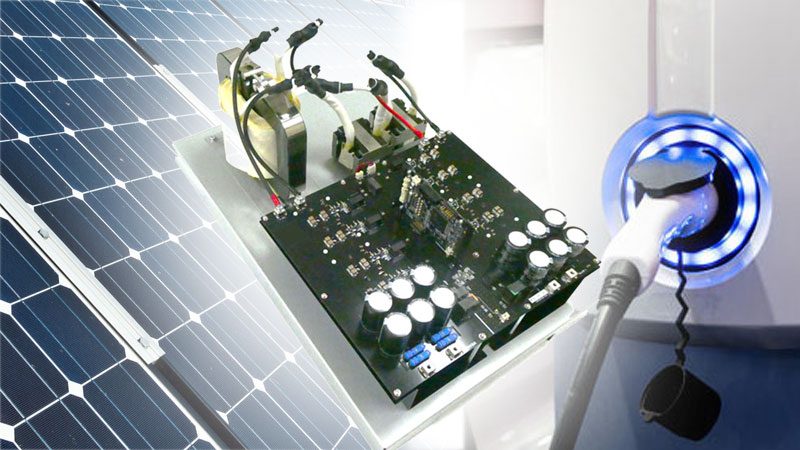
The 5 kW Isolated Bidirectional DC-DC Converter reference design from Toshiba shows how to improve a power supply design's efficiency using SiC MOSFETs. The design uses the dual active bridge (DAB) method, one of the most popular topologies for such high-power converters. The DAB topology has full bridges on both sides, allowing the direction and amount of power to be controlled by adjusting the phase difference between the left and right bridge circuits. This highly versatile reference design forms a starting point for developing and prototyping high-power conversion applications, such as electric vehicle charging stations and inverters in solar power generators.
Feature/Specification
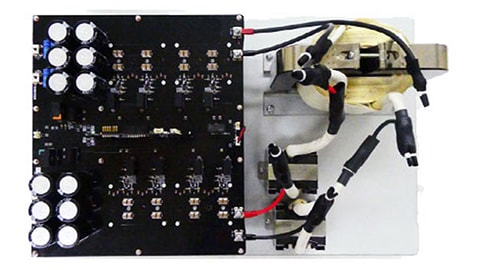
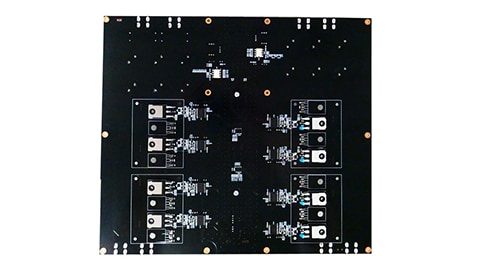
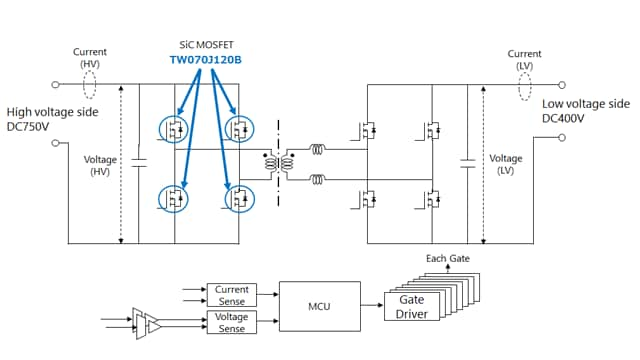
Features
- Bidirectional high-power conversion by DAB method
- High power conversion efficiency using SiC MOSFETs on the high voltage side
- Total solution including low voltage side MOSFET (TK49N65W5) and gate driver (TLP5214A)
Specifications
- High Voltage Side : DC 732 V to 768 V
- Low Voltage Side : DC 396 V to 404 V
- Rated Power : 5.0 kW
Example application
- Example application of EV charging system
- Example application of a photovoltaic inverter
EV charging system
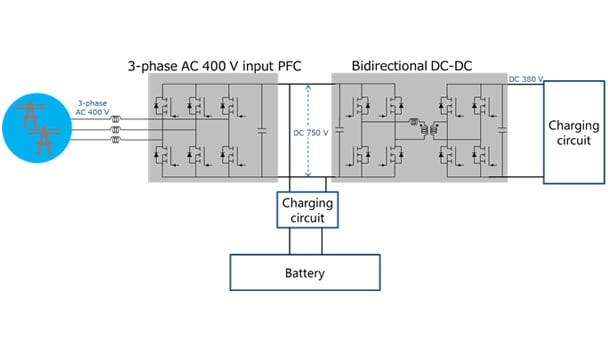
The diagram shows a system that combines two reference designs available from Toshiba. The “5 kW Isolated Bidirectional DC-DC Converter” reference design (introduced in the following article) is matched with a high-efficiency “3-phase AC 400 V Input PFC Converter” reference design. The two reference designs can be used together for quick and easy system development and are both available from Toshiba.
A photovoltaic inverter

Inverters for photovoltaic power generation (hereinafter referred to as PV inverters) require highly efficient bi-directional DC-DC converters with low loss. They are used to adjust the DC voltage level supplied by the solar panels and transfer it to the inverter and storage battery charging circuit.
PV inverters are used to convert DC voltages generated by PV panels into commercial AC voltages for use in houses and factories, or to feed them to the power system (Grid) (reverse power flow). However, the power generation capacity of solar panels depends on the time of day and the weather, and it is impossible for the PV panel to supply enough power at night or during cloudy weather. By adding a battery that stores surplus power during favorable weather, we can build a system that can provide a stable supply of electricity whenever it’s needed.
Bi-directional DC-DC converters are indispensable in providing power from storage batteries to the power system, and vice versa, providing power from the power system to the storage battery. Highly efficient and bidirectional operation uses isolated DC-DC converters to create a PV-inverter system that utilizes limited power with low-loss performance.


